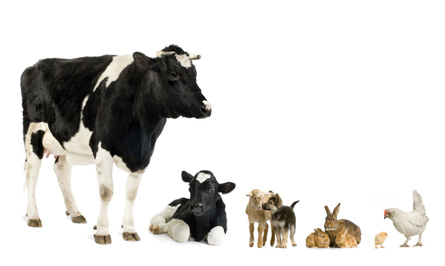Module 6
1. Module 6
1.3. Lesson 1
Module 6—Mendelian Genetics: The Transmission of Traits to the Next Generation
Lesson 1—Theories and Terminology of Inheritance
 Get Focused
Get Focused

© TheSupe87/shutterstock
A prize pumpkin at a county fair must be large, well-shaped, have good orange colour, and be disease-free. These descriptors are called characteristics, and gardeners who wish to compete in county fairs are constantly selecting plant seeds that come from vines demonstrating more of the characteristics they want in their pumpkins. Breeding plants or animals to reflect desired characteristics or behaviours is called selective breeding and has been used throughout recorded history.
However, only since the 1850s have scientists developed understanding of how those desired characteristics are actually passed from one generation to the next. How these characteristics are passed on, or the study of inheritable traits, is the focus of genetics.
selective breeding: choosing stock because of its physical, behavioural, or functional characteristics
inheritable trait: a characteristic that is determined by genes, not the environment; a trait that is capable of being passed from parent to offspring
In this lesson, you will explore and become familiar with the language of genetics. In this lesson and throughout the module you will be introduced to many new terms. Your lesson assignment will involve developing flash cards to support your developing genetics vocabulary. Add to it as you work through the module. You will also be introduced to a nineteenth century monk, Gregor Mendel, and learn why he is considered the “Father of Genetics.”
In this lesson, the following focusing questions will be examined:
- What is the basic language of genetics?
- How does the work of Mendel explain the basics of classical genetics?
 Module 6: Lesson 1 Assignment
Module 6: Lesson 1 Assignment
Your teacher-marked Module 6: Lesson 1 Assignment requires you to submit
- vocabulary flash cards
You will create flash cards for each new term introduced to you throughout this lesson. You may develop your flashcards as a Word document, a PowerPoint, or any form that you choose to meet your learning style. You may wish to consult with your teacher for suggestions. Your flash cards for this lesson will only be submitted to your teacher for assessment at the end of the lesson. For additional information on this assignment and a rubric for assessment, see the Reflect and Connect section of this lesson.
In each of the following lessons, add new terms, diagrams, or tools used in genetics to complete your set of flash cards. Use your flash cards as a study tool for the terms and concepts presented in this module.
There is no assignment for this lesson.

© Eric Isselée/shutterstock
The other questions in this lesson are not marked by the teacher; however, you can submit any of this work to your teacher for feedback if you require. The “Self-Check” and “Try This” questions are placed in this lesson to help you review important information and build on key concepts that may be applied in future lessons. The key to success in genetics is “practice.”
While you are completing this lesson, there will be many opportunities for you to acquire, understand, and practise the concepts that are presented to you. As you complete these activities and your summary notes, you will file everything in your course folder so that you may refer to these when you are preparing for exams.
Remember you also have the option of trying additional questions from the textbook for further practice. Consult with your teacher for the answers to these questions. The Key will also provide you with many Diploma-Exam-style multiple choice, numerical response, and written response questions that will be an excellent review of the module. Practising responding to these types of questions is good preparation for the Diploma Exam.